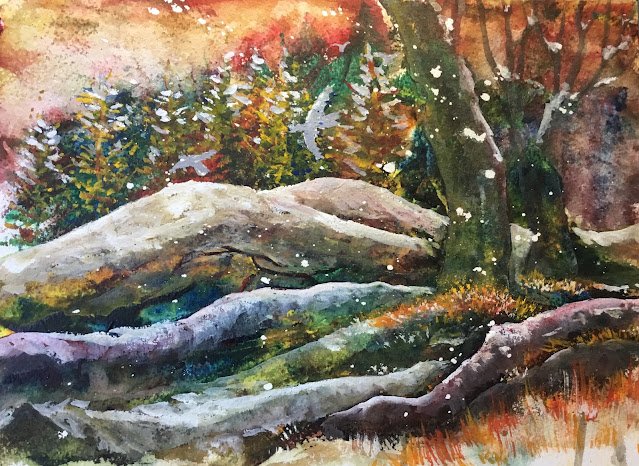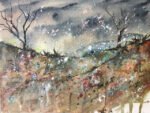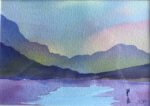I was short of ideas today, so watched a few Jean Lurssen videos on YouTube…

The South Wind
Yesterday was a day off but I’m back painting again today. I’m still not feeling up to painting some dead serious watercolours with my usual palette and mainly based on three primaries – that might just have to wait until all the stress is over and my studio is up and fully operational. That means that if I’m not going to be using the supergranulators as a cheat code, I’m just going to have fun instead with abstract landscapes.
Today the plan was to have a go at repeating some earlier successes by applying paint with a knife straight from the tube and to see where it took me. And to have a lot of fun along the way. I started, though, by marking in some birds with masking fluid with the idea that even if I ended up with a psychedelic mess on the paper, it could be interpreted as some sort of landscape. I also spattered on masking fluid to create magic in the air.
For my starting colours, I went for Winsor red, light red, transparent yellow, cobalt blue, Prussian blue, bunt umber, burnt sienna and viridian. The light red, cobalt blue and Prussian blue aren’t on my first choice palette and need to be used up at some point, so why not start here? Any concerns about the long term lightfastness of Prussian blue didn’t concern me here: it’s not a big deal if one of the blues turns to grey at some point (and that’s still an if) then it’s less of a big deal in an abstract painting. The green and the earth colours are feeling a little underused, hence their call up. And Winsor red and transparent yellow were the colours needed to brighten things up in the resulting set.
Once the masking fluid had dried, I squeezed out pea sized bits of of paint and then applied these to the pre-wet paper with a palette knife and spread and mixed them, all fairly randomly. Some of the knife marks started to look like a tree and some fallen branches and I was happy to encourage this. I fiddled a round with things, spraying on water and throwing on salt without much to show for it. The most important thing I did at this stage was to work on the sky. I first added water to smooth it out and found it was looking too red and dark valued but the addition of some yellow and some dabbing with a kitchen towel got me to something acceptable.
After the paint had dried, I started working on coaxing a landscape out of these random marks. I added all those background trees on the left using my original colours plus cadmium yellow, which I find is often required to make trees stand out against what’s behind them. I then moved onto the foreground and, after having no luck trying to use my original colours, introduced cadmium yellow and cadmium red to the team. I used these opaque colours to harden existing edges and to add new edges. The marks I made tended to be hard edged along one side (the edges of tree trunks) but soft edged along the other side (to give the impression of the trunks being round). I found that this actually worked and was starting to turn this into something looking like a landscape.
And rather than stopping there, which I could have done with a clear conscience, I kept tinkering. Because this painting was all about having fun, remember? So I brought in the titanium white and added some snow. I added it in the trees and along the tops of the hills and fallen branches. Just as with the cadmium colours, I was careful to have hard edges along the top of the snow and soft underneath to create a 3D effect. The 3D effect came out so well that I even started using the white in places as a glaze where there wasn’t any snow, just to strengthen shapes and create depth. In places the white paint picked up some of the colour underneath it, which was also great. I also added some long grass marks in the foreground and shorter ones below the trees using the Merlin brush and the three opaque colours.
Finally, I removed all the masking fluid and found that I needed to paint over the birds where some paint had got underneath the masks. I ended up with making them a cloudy grey colour which wasn’t ideal but I felt I was reaching the point at which any more changes to the painting would only worsen things. So that was me done.
So what did I end up with? A painting reminiscent of Sastrugi a couple of years ago. The main difference compositionally is that I have a big vertical shape to contrast against the horizontals. And there’s a change to the questions that spring to mind: with Sastrugi, the mystery was around whether the painting depicted snow or water but now the question is whether those are fallen branches or just the lumps in some uneven ground. Maybe some of the lumps are the ground and some branches? Some of them look like silver birch branches. Don’t ask me what they are; I’m only the artist. But whether they’re hillocks or branches, the colours in them are amazing, the blues and reds in particular.
This one’s definitely a success and it’s up for sale. The name comes from an Algernon Blackwood short story. To see the price, click here.








Leave a Reply